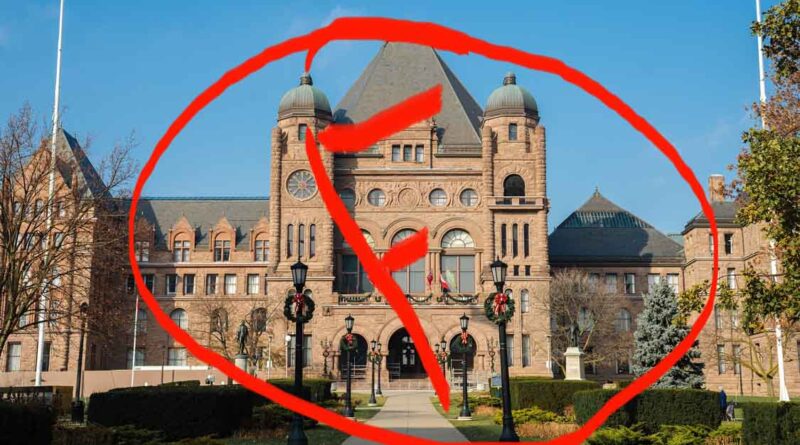Ontario’s Climate Change Report Card
The Ontario government is failing to meet the climate challenge.
With the world leaders having met at COP27 and COP15 over the past six months to consider concrete actions to respond to the climate crisis, Sustainable Orillia believes it appropriate to take a look at the Ontario provincial government’s record over the past few years to see where we are. In putting this report together, we looked at various aspects of sustainability, the challenges of climate change across our province, and the actions that are being recommended across the globe.
Sustainable Orillia is not politically affiliated and nothing would be more satisfying for our membership than to give whatever government, including our current one, straight A’s.
ACTIONS REQUIRED, NOW AND FOR THE FUTURE
Action 1: Protection of land (farmland and forest) and water
Bill 23 says it all. Allowing development in the Greenbelt reveals a complete disregard for the value of forests and sources of clean water in southern Ontario. Especially when the government’s own report not only warned against doing so, but also pointed out there was no need to do so. There is plenty of land available for needed housing without incursions into the Greenbelt. This decision is especially egregious, coming on top of plans to build new highways through the Holland Marsh area. Statistics Canada estimates Ontario loses 319 acres of productive farmland every day. (Note: The failure to protect farmland in southern Ontario can be laid at the feet of every Ontario government over the last 50 years or more. Will any government make this a priority before it’s too late?)
Action 2: Protection of species and their habitat (Biodiversity)
While the government’s ministry of the environment claims it’s protecting biodiversity, a variety of voices disagree. In her annual report Ontario’s auditor general, Bonnie Lysyk indicates the government is actually enabling harm, concluding, “the Environment Ministry’s species at risk program misses achieving its central purpose.”
Rachel Plotkin, a wildlife campaigner with the David Suzuki Foundation, agrees with Lysyk: “(The government is) really dismantling almost every single possible protection measure that the Endangered Species Act was intended to provide and it’s approving any possible habitat destruction initiative without a second thought.”
James Snider, vice-president of science, knowledge and innovation with the World Wildlife Fund – Canada notes, “Species in Ontario are already experiencing dramatic declines in population numbers, a their habitats are being further destroyed or degraded as a result of development in the province. Ignoring wildlife and habitat protection not only puts species at risk, it can exacerbate the effects of climate change on the province and the world because Canada, and Ontario in particular, store globally significant amounts of carbon in our ecosystems.”
Dianne Saxe, formerly the Environmental Commissioner of Ontario (ECO) and now deputy leader of the Green Party, said the situation is actually worse than reported by the auditor general because the audit didn’t take into account the impacts of pending major projects such as Highway 413 and the Bradford Bypass. She said the province is not enforcing the law.
With all these voices raised in alarm over the government’s actions regarding Ontario’s endangered species and habitat, it appears clear that the Conservative government is failing in this duty to protect.
Action 3: Reduced-emission transportation infrastructure
The current provincial government has committed to spend billions of dollars on transit, a positive step forward. Improving bus and subway service across the province and increasing the availability of train transportation (electrified?), especially through the Windsor to Quebec City corridor, will remove thousands of tonnes of emissions and speed commuters to their destinations.
At the same time, however, it has resurrected the plan to build the 413 highway through the Greenbelt as well as the so-called Bradford Bypass through parts of the Holland marsh and adjacent wetland areas. Toronto-based urban designer, Ken Greenberg, calls the proposal to build the highway a “terrible mistake” for the people of the GTA and the province as a whole.
“This is just such an astonishing thing to be doing,” said Greenberg. “In our province, we’ve been trying to make efforts to get away from all the automobile dependence, the terrible impacts it has in terms of climate change. It just doesn’t make sense.”
Others agree with Greenberg. Building the highway would be “an example of boneheaded economic development” that won’t improve traffic congestion, said Toby Heaps, the CEO of business research and media firm, Corporate Knights.

Ontario in 2022 also finds itself with a critical lack of electric vehicle charging infrastructure. If electric vehicles are going to replace fossil-fueled vehicles, buyers must feel confident that there will be places across the province to charge their vehicles. The Ford government has wasted four years in this area, deciding only in 2022 that ONroute service areas should offer charging facilities to drivers on our province’s major highways.
Altogether, the government gets a mixed review on this category of critical actions.
Action 4: Transition to clean energy sources
The government gets a failing grade for this category for two reasons. The first is its cancellation upon election in 2018 of all of the clean-energy initiatives begun by the previous government. This action, in addition to costing the Ontario taxpayers more than $230 million for cancelled contracts, ended “renewable energy projects that included a partially-built wind farm in a cabinet minister’s riding (and Orillia Power Generation Corporation’s Bawatik Generating Station, which cost the City ore than $2 million).” Ironically, four years later, in 2022, the current government finds itself short of electricity to meet future demands.
The second reason for this failing grade is the government’s decision in 2022 to meet these future demands by building more gas plants. While natural gas is cleaner than coal—a fuel that was phased out by the previous government—the gas plants will add to the province’s greenhouse gas emissions at a time when the goal should be to reduce them.
Category 5: Provincial Incentive Programs to spur rapid change
Although the Ontario government has not chosen to mirror other provinces to provide incentives for EV owners and charger installations, it did provide support, along with the Canadian government, for the building of the province’s first large-scale electric vehicle battery manufacturing plant. “The joint venture between LG Energy Solution, Ltd. and Stellantis N.V. will invest more than CDN $5 billion (USD $4.1 billion) to build a facility in Windsor to manufacture batteries for EVs in Canada, representing the largest automotive manufacturing investment in the history of the province. This historic investment puts Ontario on a path to becoming one of the most vertically integrated automotive jurisdictions in the emerging North American EV market.” The facility will be operational by 2025.
The Ontario government also provided GM Canada with $259 million to transform its CAMI manufacturing plant in Ingersoll into an all-EV manufacturing facility, the first of its kind in Canada. The re-tooled plant celebrated its opening on December 5, 2022.
The current government’s strategy appears to be to help big business with retooling for a green energy economy, while leaving residents to rely on federal and company-provided (e.g. Enbridge) incentive programs. However, failure to provide needed provincial infrastructure will slow transition away from fossil-fueled vehicles.
And vehicle emissions are only one part of the greenhouse gas problem. Large scale retrofits for housing and commercial/industrial buildings of all types across Ontario are necessary to speed the reduction of carbon emissions by 2030. We hope to see more action in this area soon.
If you were evaluating the actions of this government in response to the threats of the climate crisis would you give an A? a D? Would it be a bare pass of even 50%?
Nothing could give us more pleasure as an organization than to be able to credit our provincial government for strong action to meet the challenges of the climate crisis. Sadly, in terms of actions on the environment and climate change, this government has little to show after almost five years in power. Many people think several of their proposed actions will do more harm than good. As a result, we cannot give a passing mark to this record.
Most distressing, given the urgency that so many around the world say is needed, is the waste of five years of opportunity to take the actions the world and its young people are expecting from governments at all levels. The people of Ontario expect better. Much better.




